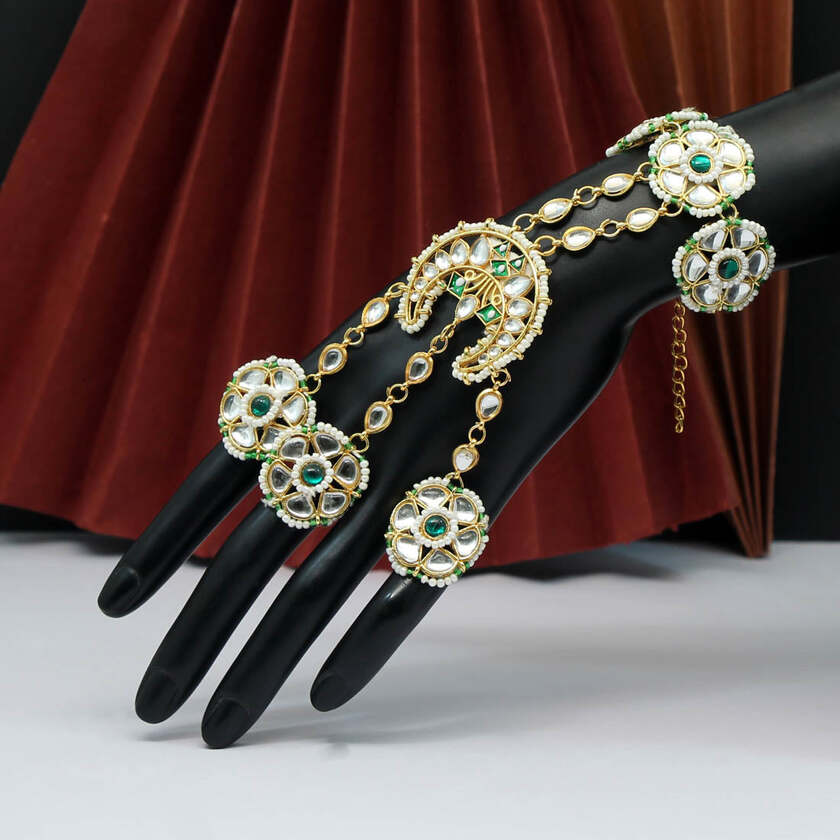In the vibrant tapestry of Indian jewelry, there’s a gem that beautifully encapsulates tradition, elegance, and cultural richness — the hathphool. The term “hathphool” translates to “hand flower,” and it’s not just a piece of jewelry; it’s a symbol of artistic expression and centuries-old heritage.
A Symphony of Tradition and Modernity
Hathphool, often worn during special occasions like weddings and festivals, is a handcrafted masterpiece that adorns the hands with delicate chains, intricate patterns, and gemstones. Originating from the Indian subcontinent, this unique piece of jewelry seamlessly blends tradition with modern aesthetics.
Picture this: delicate chains intricately woven around the fingers, connecting to a beautiful centerpiece that rests on the back of the hand. The design is as diverse as the regions it hails from — from the elaborate Rajasthani hathphools boasting Kundan and Meenakari work to the simple, chic ones inspired by contemporary fashion.
A Symbol of Cultural Richness
The hathphool isn’t just a piece of jewelry; it’s a symbol of cultural richness and historical significance. In many Indian cultures, jewelry is more than an accessory; it tells a story, weaving together the threads of tradition and heritage.
In Hindu weddings, for instance, the hathphool plays a pivotal role in the bride’s ensemble. It symbolizes the coming together of two families, their histories, and the intricate connections that bind them. Each element of the hathphool holds cultural significance, making it a cherished part of the bridal attire.
Craftsmanship at Its Finest
What makes hathphool truly exceptional is the craftsmanship that goes into creating these intricate pieces. Skilled artisans painstakingly mold metals, set gemstones, and craft elaborate designs, transforming raw materials into wearable art.
Whether it’s the glimmering gold of South India, the vibrant enamels of Jaipur, or the polished elegance of silver from Gujarat, each hathphool reflects the distinct craftsmanship of its region. The meticulous attention to detail and the passion infused into every creation make hathphool not just an accessory but a testament to the artisan’s skill and dedication.
Versatility Redefined
One of the most enchanting aspects of hathphool is its versatility. While deeply rooted in tradition, it has seamlessly adapted to contemporary fashion. Today, you can find hathphools in a myriad of designs, catering to diverse tastes and preferences.
Whether you prefer a classic, ornate hathphool for a traditional occasion or a minimalist, modern design for a chic look, there’s a hathphool for every style. It effortlessly transcends generational and cultural boundaries, making it a timeless accessory that resonates with women of all ages.
In the kaleidoscope of Indian jewelry, the hathphool stands out as a symbol of timeless elegance, cultural pride, and exquisite craftsmanship. Wearing a hathphool isn’t just adorning your hands with jewelry; it’s a celebration of heritage, a nod to tradition, and a testament to the evolving artistry that defines the world of Indian jewelry.
So, the next time you slip on a hathphool, let it be more than an accessory — let it be a connection to the rich tapestry of Indian culture, an ode to craftsmanship, and a celebration of the enduring allure of handcrafted elegance.


















